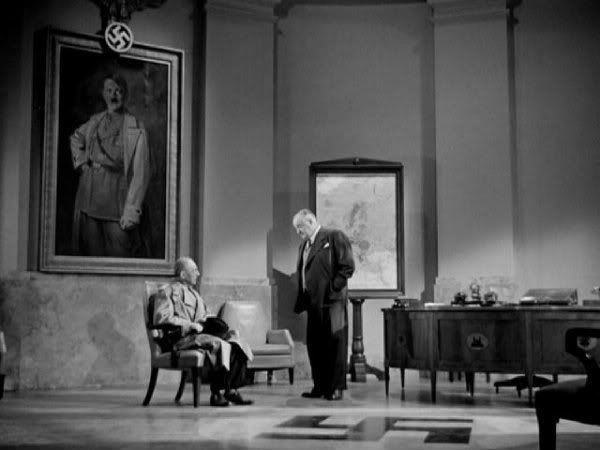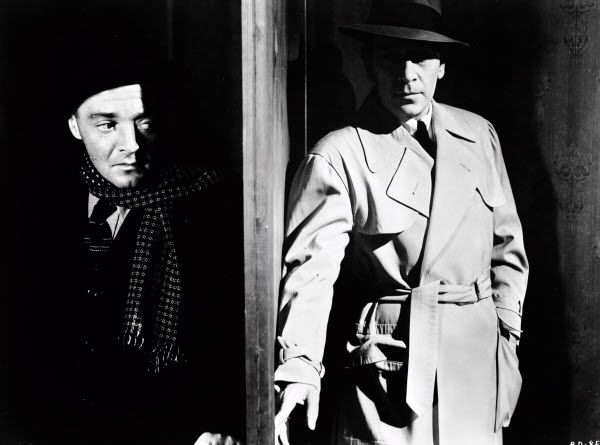
This was easily the most satisfying film I’ve watched so far in my Unseen Lorre Fest. Passage to Marseille was probably a better film (and certainly portions of it were markedly superior). Still, Lorre has a pretty juicy part in this one, is allowed to ham things up and thankfully receives a pretty decent amount of screen time. And the movie does move. That was a relief after the plodding, near Lorre-less They Met in Bombay.
Yet another film clearly meant to capitalize on Casablanca, Background to Danger is the inevitable foreign intrigue dealie. It stars George Raft, who I was never a particular fan of, and I couldn’t help but dwell on how much better the film would have been with Bogie starring. Still, Raft is serviceable in the role, playing a two-fisted American, and in general it’s a fairly decent programmer. It’s blessed particularly by its efficient 80 minute running time.
The setting is Turkey, which a prologue explains is a rare island of neutrality surrounded by countries (as portrayed in the prologue, literally) aflame with war. I’d say the picture was a high ‘B’ or middling ‘A.’ There’s no real superstar in the cast. However, the sets are sumptuous, and there’s a pretty good supporting cast. Topping this are Lorre, the inevitable Sydney Greenstreet, and an underused Turhan Bey. Any buff of films from this period will see the usual parade of familiar faces playing waiters, cops, etc.
Aside from the cast, the film is based on a book by Eric Ambler (as was another Greenstreet/Lorre film, Mask of Dimitrios), one of the great spy novelists of the first half of the 20th century. The able direction is by Raoul Walsh, best known then for his top-notch, noir-ish gangster movies like They Live by Night, High Sierra and The Roaring ‘20s. Eventually he went on to direct White Heat, perhaps the greatest gangster film of all time. Meanwhile, the opening montage is co-credited to a young Don Siegel, who went on to become a pretty terrific director himself. Among other films, he helmed the original Invasion of the Body Snatchers as well as Dirty Harry.
The opulent set design and cinematography are impeccable, and the film, available on a remastered burn-on-demand DVD-R through the Warners Archive Collection, looks pretty sweet. Personally, I had been hoping for years that Warners would release a DVD box set feature a batch of the many Greenstreet / Lorre collaborations (they appeared in 10 movies together, although usually not as the leads). That ship has sailed, though. The Warners Archive Collection has been a huge smash, which is evident in that Universal, Sony and MGM have followed in Warners’ footstep with this burn-on-demand idea. Too bad. That said, most of the Warners DVD-Rs I’ve bought have looked smashing.
Raft in an American salesman traveling through Europe when he spies a pretty young thing and chats her up on the train. (Per usual, the train is mostly realized through some pretty fabulous model work. The one glitch in this regard is a short shot of a doll used to represent Raft clinging to the side of the locomotive.) She ends up dead—sorry, if that’s a spoiler for you, you haven’t seen many war films from this period—and Raft ends up with the inevitable MacGuffin, one the Nazis desperately wants to get their hands on, since they can use it to draw Turkey into the war on their side.

Sidney Greenstreet is the head Nazi, and gets one of the three above the title acting credits, along with Raft and Brenda Marshall (a rather useless female lead, there for strictly pro forma reasons). Lorre appears at the top of the supporting actor roster following the title card, but as noted, he has a nice big role here. Greenstreet, playing his Nazi in a rather Kasper Gutman-esque fashion, is clearly a baddie. Not so obvious is the shifty Lorre’s role in things. Raft, needless to say, doesn’t know who to trust.
Raft, playing a fairly one-note tough guy, can’t really compete with Greenstreet, and gets blown off the screen by Lorre. While Greenstreet is forthrightly bad and Raft forthrightly good (if a bit of a skirt chaser), Lorre has the advantage of ambiguity. For much of the film we remain unsure as to what side he’s on, which works to his advantage. He’s always skulking around and being mysterious. Lorre plays his role with literally childish enthusiasm, constantly sliding from a mercurial glee to chagrin and back again.
All of Lorre’s trademarks are on display here; his eye-popping, verbal clucking and so forth. And as he often did in his younger, more limber days, Lorre occasionally splays himself across furniture to draw the audience eye, here sitting up atop a table with his legs tucked under him, or lounging on a sofa arm. Walsh pretty much lets him run wild, although more in a ‘guy massively amused by his own antics’ fashion befitting the character (although also true, no doubt, of Lorre himself) than just a pure ‘over the top’ manner. Anyway, Lorre is a lot of fun here.


Lorre, Mary Astor and Humphrey...oops.
One continuity error to note: At one point Raft reaches into a box containing a revolver, and draws out a Luger instead! Not sure how that passed muster. Also, I have no idea what the title means. It’s almost like a generic suspense placeholder that they forgot to replace when they released it. And in retrospect the film is woefully naive about how the Russians were now our good buddies, at least since Hitler abrogated the Hitler / Stalin pact in the most direct fashion possible.
All in all, I’d give this a solid three stars just as a movie, and three and a half stars as a Lorre movie. It’s not one of many iconic roles, but it’s definitely a keeper.
